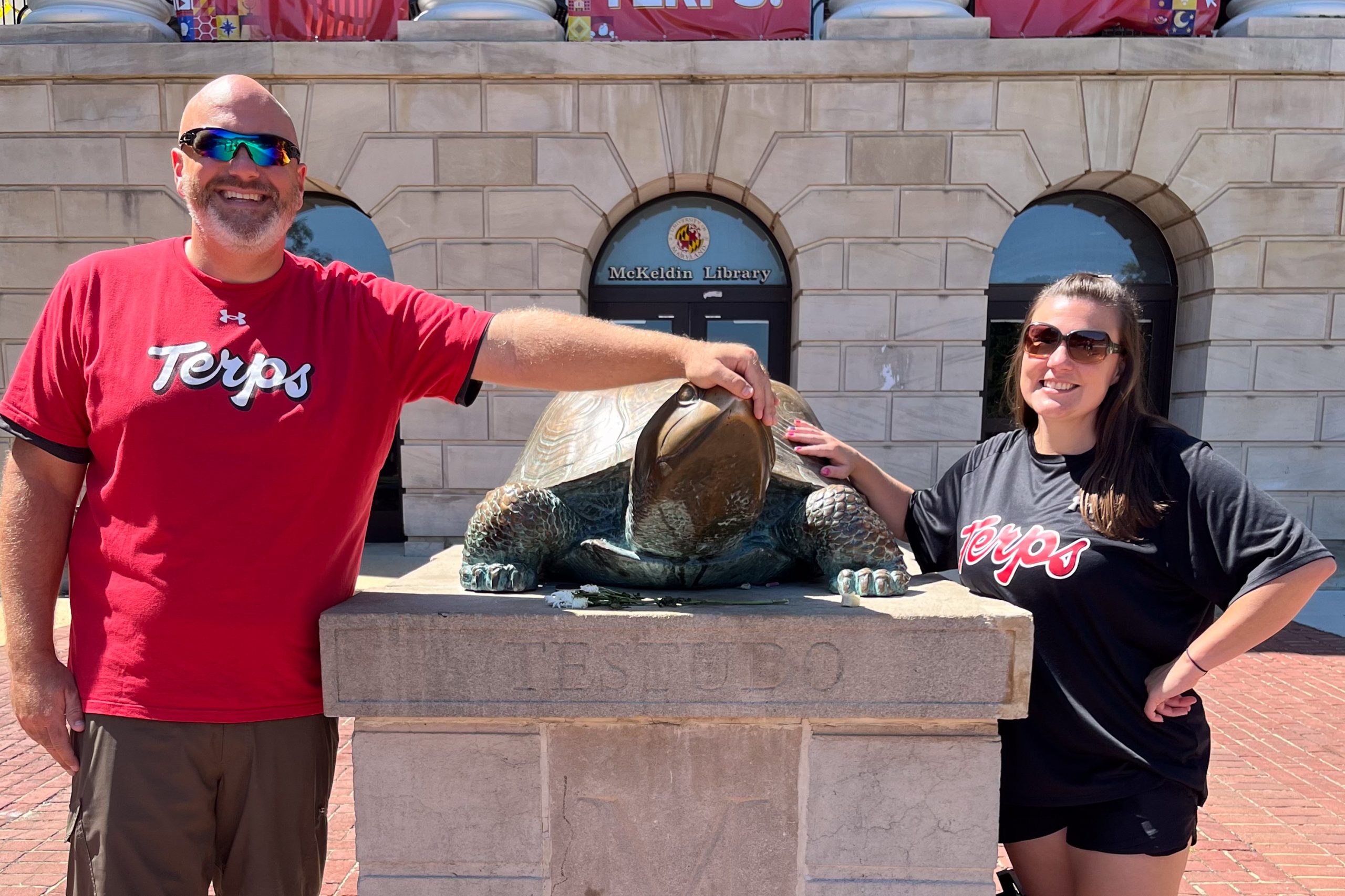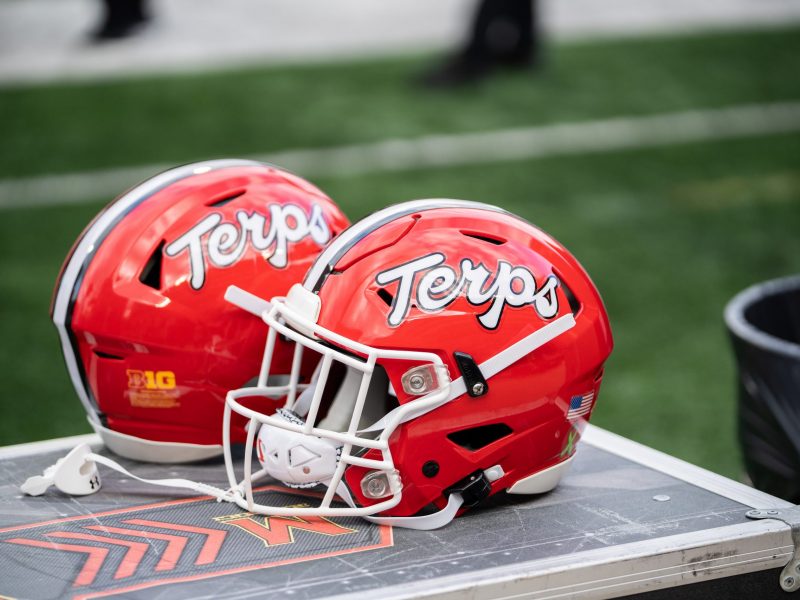Kris Santos had the same routine most Saturdays this fall.
He and his wife left their Yorktown, Virginia, home early — sometimes before the sun rose. They took U.S. Route 301 and Route 5 to skip traffic on Interstate 95 and, nearly four hours after they departed, finally arrived in College Park to watch Maryland football.
Despite the distance, Santos attended every Terps home game this season. He’s part of a larger community of Maryland fans who travel more than 100 miles to watch their team. Their unrelenting dedication fueled one of college football’s largest attendance increases this season.
Now, Santos is urging fellow Maryland fans to join him.
“People need to understand that it kinda starts with the fans,” Santos said.
Santos, a Laurel native, graduated from this university in 2011 and moved to Yorktown to teach middle school. That’s where he met his now-wife, Brandy. They got married in 2018.
For the first time in his life, Santos was separated from the Terps after moving. The round trip can take more than seven hours of driving, which meant he could only attend two or three games each season.
Not going to SECU Stadium on Saturdays discouraged Santos, especially when he saw the Terps’ home games at half capacity. He recalled watching the Terps play Kent State in 2021, their last nonconference game before a matchup with then-No. 5 Iowa. The bleachers were nearly empty.
“We’d turn on the TV, and the stands would be half full, and that’s generous,” Santos said. “I’d be like ‘Man, why didn’t we go? Why didn’t we just drive up for the day?’ I would just regret it.”
So when the team announced a season-ticket package for just $99 before the 2023 season, he jumped at the offer.
[For Keion and Keyshawn Flowers, committing to Maryland football fulfills a lifelong dream]
Santos and his wife went to every home game this season, from the Terps’ season-opening 38-6 beatdown of Towson to their seven-point loss in their closing game against Michigan. He brought his stepdaughter to the Penn State game. The final home game fell on Santos’ birthday, so he rented a van and brought 15 friends with him.
Every Saturday followed a meticulous schedule. For a 3:30 p.m. start time, the couple left at 9 a.m. The pair took the day off work for Maryland’s Friday night game against Virginia. And for the Terps’ lone noon game in College Park, they left Yorktown at 4:45 a.m.

Santos watched from section 309 in the first row of the upper deck. There, he encountered more Terps supporters who trek similar, sometimes even longer, distances than him. He met one man who came from Delaware and another who lived further away in Virginia.
“It’s really cool connecting with people there. They’ve been sitting there for a long time,” Santos said. “You hear their stories and you’re like, ‘Oh man, these are really cool people.’”
Diehard fans like the ones who traveled to watch from section 309 contributed to one of the largest attendance upticks in college football this season.
Maryland still ranks near the bottom in average attendance — the Terps are 56th in the nation and 13th-worst among Power Five programs. They’re 75th in average capacity percentage, the 11th-worst mark in Power Five.
“I think the fan attendance is probably our biggest issue,” Santos said. “For the life of me, I can’t understand it.”
But Maryland’s 26.24 percent increase in announced attendance this season from 2022 was third best among Football Bowl Subdivision teams. The Terps had two games this season with more than 49,000 fans in attendance. They had one such game across the last four seasons combined.
Slowly, the fans are returning to SECU Stadium.
[Maryland football to play Auburn in TransPerfect Music City Bowl on Dec. 30]
Maryland staffers attribute the rise to ticket discounts and a 130 percent increase in the marketing department’s advertising budget. Being able to watch a year of Big Ten football live for $99 is “pretty unprecedented,” said Jordan Looby, Maryland athletics’ associate athletic director in charge of marketing strategy and fan experience.
“We took a really aggressive stance on pricing with our tickets,” Looby said. “We also wanted to provide a lower get-in price for people so that a barrier to entry didn’t really exist for someone based upon price.”
Maryland sold out of its $149 season-ticket packages for sections 17 and 18, Looby said. The team has also moved to mobile ticketing and parking in the last few years, which he feels eliminated previous roadblocks.
This year’s budget increase was more than six times the increase the department received in 2022. A lot of the additional funding was directed to digital advertising, Looby said. It also allowed for more billboards and other projects.
“This is an expensive market,” Looby said. “If we aren’t able to invade the market in any way, then Maryland football will just be less of a thing to people.”
Thanks for the comment!
We drive up 3.5 hours and home 3.5 hours every Saturday. Rain or shine. People will come out when we are “good” but nobody wants to get in on the ground floor first.
My wife and I look at ourselves as part of the rebuild too. pic.twitter.com/t2FycTQpKM
— KS (@Kristop38560529) November 26, 2023
Santos longs to see a full SECU Stadium. Maryland nearly achieved that twice this season.
When he was surrounded by empty bleachers, Santos put himself in the mind of a recruit who saw a stadium devoid of energy on a gameday. He wondered: Would they choose the Terps over conference rivals, who boast stadiums with more than twice as many fans?
Santos wants to change how Maryland is perceived. He believes it starts with fans like him, a realization that made him spend seven hours on the road almost every Saturday for the last three months.
“The team’s not going to be great unless fans start coming out and paying a few bucks,” Santos said.




